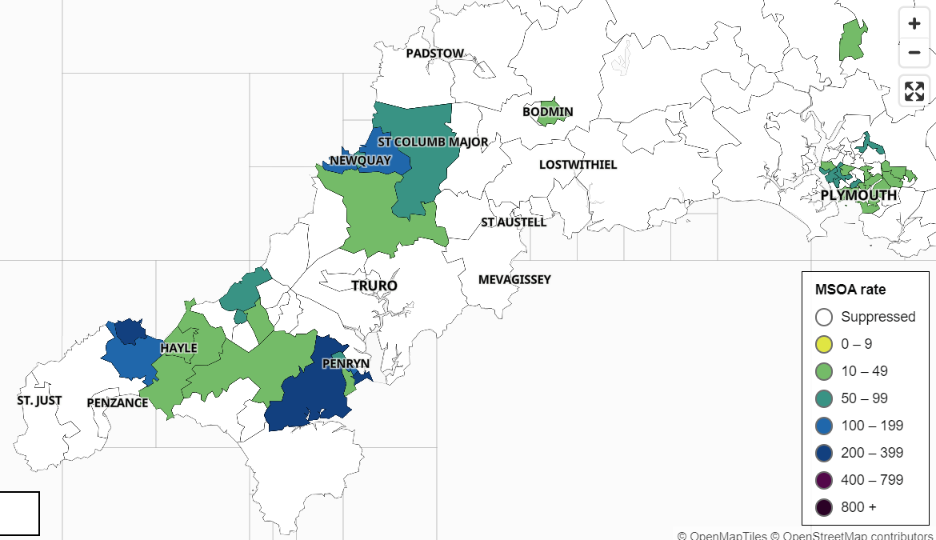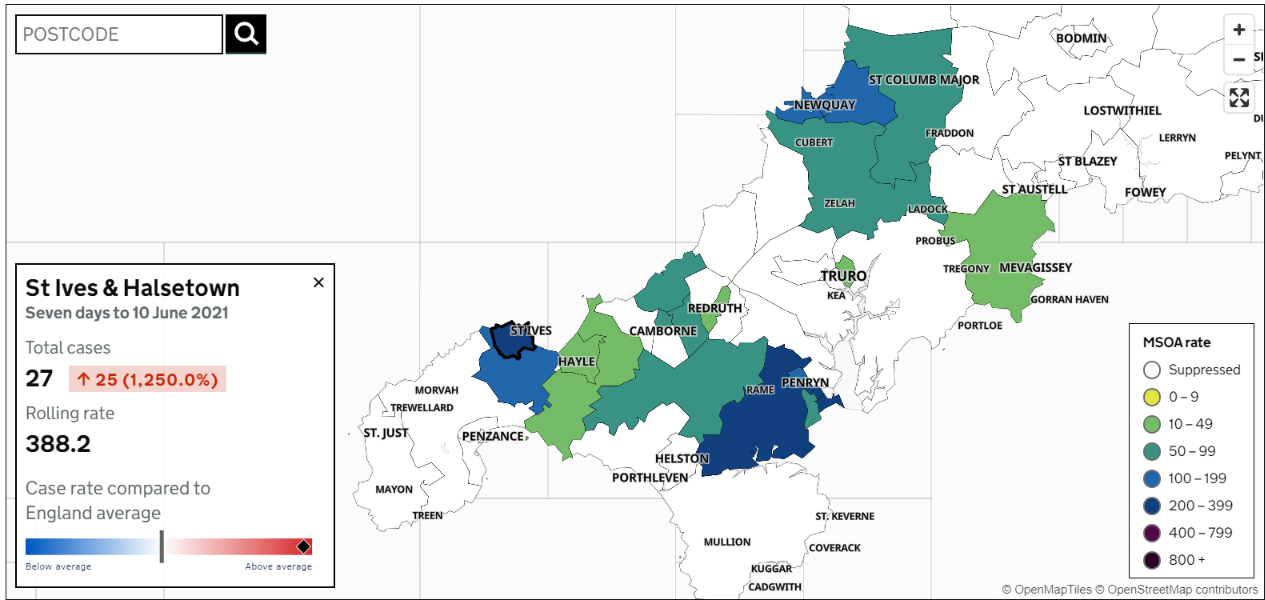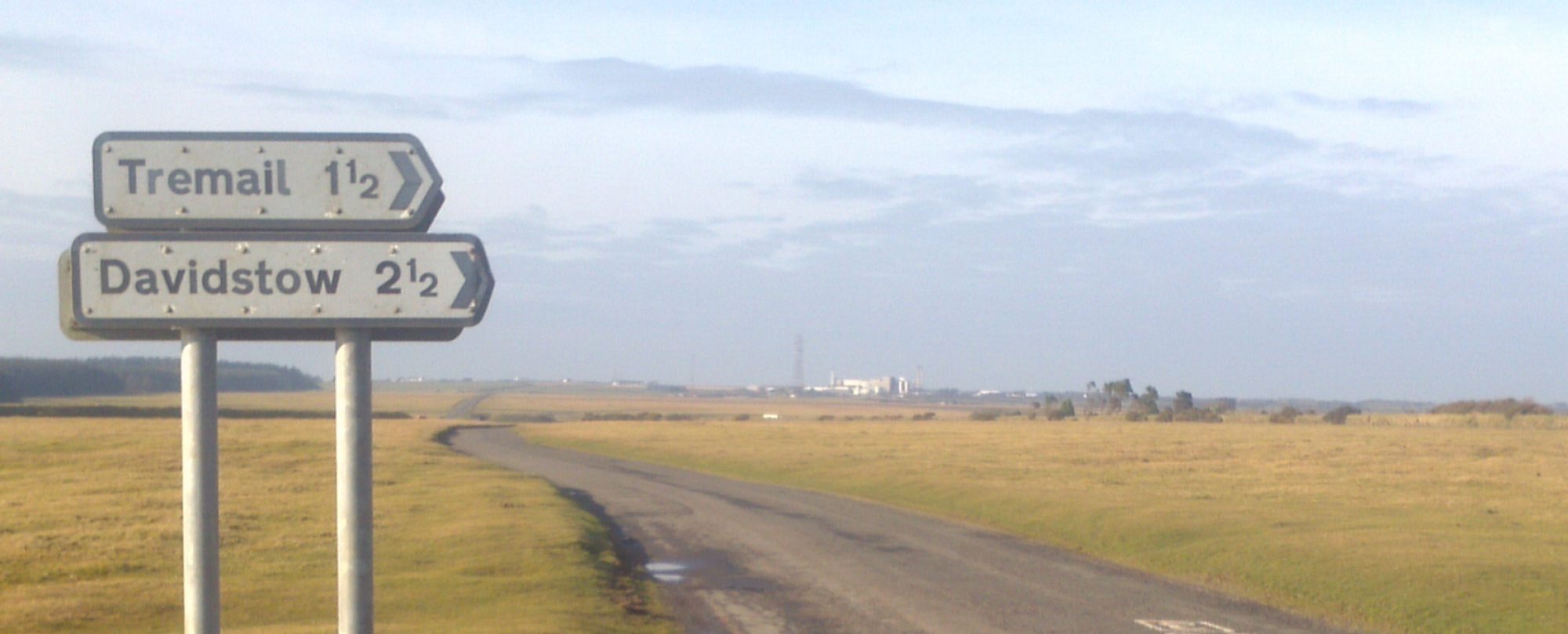We commented yesterday on the current outbreak of Covid-19 cases further west in Cornwall than Davidstow, and suggested that the cause may be the recent G7 Summit in St. Ives, which finished on Sunday.
Here is yesterday’s map:

Together with a “heatmap” showing the age distribution of cases across Cornwall as a whole:

The far right of the image suggests that during this so called “third wave” of Covid-19 cases, the 15 to 24 age range has been the hardest hit. Possibly that’s because this section of the population has yet to be vaccinated?
The official data for June 10th have also just been released, and this is how the latest map looks:

Truro, Redruth and Mevagissey are no longer pure white, as they were on June 9th. A total of 27 cases in St. Ives doesn’t sound like a lot, but it’s an enormous percentage increase on the previous 7 days.
Watch this space!

There have been suggestions elsewhere that the recent Bank Holiday is to blame for the sudden rise in Covid-19 cases in Cornwall:
However there is a strange absence of such a rise in holiday destinations north and east of the “G7 zone”:
As The Guardian pointed out at the weekend:
In today’s data release, now including June 11th, Cornwall as a whole has turned a deeper shade of blue/green:
Zooming in further, the south coast outbreak is now outdoing the north coast percentage wise:
The latest official Covid-19 data for Cornwall have been released, now including June 12th:
The case rate is now 71.9 per 100,000 people for the county as a whole.
Zooming in once again, the St. Ives case rate is now up to 632.5 per 100,000 people:
Here too is a closer look at the Cornwall heatmap, showing that the highest case rate is currently in the 20-24 age group:
Covid-19 cases across Cornwall in the week after the G7 Summit are still rising apparently inexorably.
The data now includes June 13th. The case rate is now 81.7 per 100,000 people across Cornwall as a whole:
The figure for St. Ives is now up to 733.2 per 100,000:
I also gleaned the following intriguing item of information via Twitter:
As I put it over there:
Public health data withheld because of alleged “national security” concerns and/or because to release it would “cause the public to panic”! Should the Cornish public be in a state of panic at the moment? Over the secrecy if not over the SARS-CoV-2 virus?
Cornwall as a whole is on the verge of crossing the weekly 100 cases per 100,000 population threshold, and turning blue on the map:
Meanwhile St. Ives has turned black, with over 800 cases per 100,000 population per week:
The official Covid-19 data for England has now been updated to June 15th. The Middle-layer Super Output Area (MSOA for short) including Camelford and Davidstow has turned green on the Covid-19 cases map, with a rate of 41.4 cases per 100,000 people per week:
Further west the case rate in St. Ives has increased further, although the enormous weekly percentage increase has dropped as the tiny number of cases 8 days ago drops out of the rolling calculation. Falmouth East has also turned black, with a case rate of 885.7:
As we surmised yesterday, Cornwall as a whole has moved into the next highest range, with a case rate of 117.5:
No change for Camelford, but the case rate in St.Ives and Falmouth East has dropped below 800:
However Falmouth North now tops the list, with a rate of 840.7 cases per 100,000 people per week:
The case rate across Cornwall as a whole has moved up to 130.6:
According to the Guardian earlier today:
Meanwhile data is now available up to June 17th. In West Cornwall St. Ives is back in the black, with a case rate of 905.7 per 100,000 people per week. On the south coast Falmouth North now has a case rate of 827.9:
In North Cornwall the Newquay West MSOA is also now in the top category with a case rate of 824.0:
Across Cornwall as a whole there are now 826 weekly cases of Covid-19, with the rate up to 144.5:
Covid-19 case data is now available up to June 18th. In West Cornwall St. Ives is the worst hit MSOA once again, with a case rate of 876.9 per 100,000 people per week:
In North Cornwall Newquay West is even worse off, with a case rate of 878.0:
Across Cornwall as a whole the case rate is up to 147.8:
Following on from yesterday’s statement by “a spokesperson” for the Prime Minister, Independent SAGE member Dr. Zubaida Haque had this to say:
The Covid-19 case rate across Cornwall as a whole has reached over 150 cases per 100,000 population per week:
The highest case rates in West Cornwall have reduced slightly, but the rate in St. Ives is still over 800:
Much the same story in North Cornwall, with the non white area of the map increasing. The case rate in Newquay West is also still over 800:
Regional Covid-19 data is now available up to June 20th. Weekly cases in the Camelford and Davidstow MSOA have risen to 4, which is enough to move the area up a category with a case rate of 55.2 per 100,000 population per week:
Further west St. Ives is still in the top category albeit with a reduced case rate of 805.1. The rate in Newquay West has also reduced to 837.5:
The case rate across Cornwall as a whole is still increasing, and has reached 154.6:
Note that next door in North Devon the case rate in Torridge has risen above 100 for the first time during the “third wave” of Covid-19 in the West Country. There is a hotspot in Great Torrington, where the rate is now 367.9.
Here too is the latest age group heatmap for Cornwall:
Case rates are increasing for all ages, with the highest rates in the 15-29 age group.
On June 22nd there were 4 hospital beds in Cornwall occupied by patients suffering from Covid-19. One of those is on a mechanical ventilator.
With case data now available up to June 21st, the Camelford area has dropped down to 3 weekly cases of Covid-19. However Newquay West is still in the top category with a case rate of 864.5 per 100,000 population per week:
Further west St. Ives has also dropped below the 800 case rate threshold:
Across Cornwall as a whole the case rate has decreased slightly, and now stands at 152.0:
Meanwhile over the border in North Devon there is a cluster of 26 cases in Great Torrington, where the case rate is currently 434.8:
On his Sunday morning show Andrew Marr has suggested that “I had a bit of Covid last week, despite being double jabbed”:
It seems that Andrew thinks he was probably infected whilst covering the recent G7 Summit here in Cornwall:
The Camelford area has dropped again to less than 3 weekly cases of Covid-19 in the data including June 22nd. Newquay West has also dropped a category with a case rate of 729.4 per 100,000 population per week:
Conversely the case rate in St. Ives is back up to 862.6:
Across the county as whole the case rate is almost unchanged at 150.2:
In North Devon the rate in Great Torrington is still increasing, and is up to 568.6 today:
In the data including June 23rd the Covid-19 case rate for Cornwall as a whole has dropped slightly to 148.5 per 100,000 population per week:
The rate in St. Ives has dropped again:
as has the rate in Newquay West:
The Covid-19 case rate across Cornwall has risen to 153.0 per 100,000 population per week in the June 24th data:
In West Cornwall the case rate in St. Ives is still decreasing. On the south coast Falmouth East is now the leading MSOA, with a case rate of 685.7:
In North Cornwall Newquay East has now overtaken the west of the town as the MSOA with the highest case rate, currently at 592.0:
With data now available up to June 27th the Camelford and Davidstow area is back on the Covid-19 case map with a case rate of 41.4 per 100,000 population per week:
Further west Falmouth North is the worst affected MSOA with a rate of 598.6:
The rate across Cornwall as a whole is still gradually increasing, and has reached 163.7:
On June 29th there were 13 Covid-19 cases in Cornish hospitals, including one requiring a mechanical ventilator. Sadly there have also been 2 deaths within 28 days of a positive Covid-19 test in Cornwall in the week ending June 29th